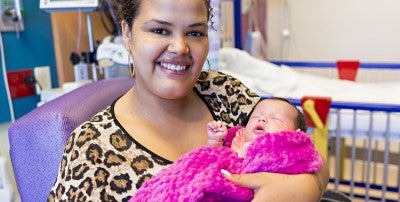
Wilka Perez was beyond thrilled when she learned she was pregnant earlier this year. But the Reading woman also worried that her baby might develop the same life-threatening anemia that caused her first baby to die in the delivery room and her 20-month-old son to be born with hydrocephalus (a buildup of cerebrospinal fluid in the skull). “I have Rh-negative blood, which wasn’t compatible with their Rh-positive blood,” she says. “With this baby, I asked my doctor in Reading for every test to prevent problems.”
A deadly disorder
Perez, 20, prayed that she and the new baby (a girl) would have compatible blood types, but test results quickly dashed her hopes. Not only was this baby also Rh positive (meaning her red blood cells carried the Rh protein) but, based on specialized ultrasound tests, the baby was already dangerously low on healthy red blood cells.
Fetal anemia from Rh isoimmunization occurs when an Rh-negative mother develops antibodies to Rh-positive red blood cells; these antibodies can then cross the placenta and destroy an Rh-positive fetus’s red blood cells, resulting in fetal anemia. Rh immune globulin injections can prevent the development of these antibodies, and are routinely given during pregnancy to Rh-negative mothers. In most cases, the “Rh shot” is successful. But once antibodies are produced, Rh immune globulin does not work, and each following Rh-positive baby may require blood transfusions in the womb to treat life-threatening anemia.
Perez was first diagnosed with Rh isoimmunization when she was pregnant with her son. Doctors believe she began producing undetected antibodies during her first pregnancy in the Dominican Republic, and suspect that this is what her first child died from.
Lifesaving action
Neither her Reading doctor nor one she saw in Philadelphia perform fetal transfusions, so Perez was referred to Lehigh Valley Health Network (LVHN) maternal fetal medicine specialist Meredith Rochon, MD, of LVPG Maternal Fetal Medicine–3900 Hamilton Blvd.
“Our assessment agreed that the fetus was dangerously anemic and needed a transfusion,” Rochon says. “We confirmed this by testing the baby’s blood by inserting a needle through Wilka’s abdomen, and used ultrasound to guide it into a vein in the umbilical cord. The baby, who was 21 weeks old, was very anemic, with a blood count about 25 percent of normal.”
Rochon gave the baby an immediate transfusion of blood that was compatible with Perez’s. Weighing only 15 ounces at the time, the fetus struggled to handle the 10 cc of blood needed (equivalent to a small syringe-full).
“The baby almost died during that first transfusion because she was so sick, but the next transfusions were smoother as the baby got better,” Rochon says.
Going above and beyond
Altogether, Perez and her baby underwent nine transfusions, averaging one every two weeks. She was particularly touched that Rochon and her team often modified their schedules to accommodate her special challenges. “I had trouble finding transportation from Reading and getting a babysitter for my son, so I’m really grateful,” she says.
Perez was so impressed, she asked Rochon to deliver her baby instead of staying closer to home.
On Aug. 3, almost four weeks before Perez’s due date, Rochon decided to deliver Perez and monitor the baby in LVHN’s neonatal intensive care unit (NICU) instead of performing another transfusion.
“NICU care is now so advanced that another fetal transfusion was probably riskier than a premature delivery at this point,” Rochon says.
Perez underwent her third C-section with no complications, and Baby Julianna was born healthy, weighing 6 pounds 4 ounces.
On Aug. 19, Julianna went home from the NICU. Later in August, she required a transfusion when blood monitoring showed she was anemic. Julianna is taking iron and Epogen® to help her produce more red blood cells, and is expected to enjoy full health in the future.
“Everyone at LVHN made me feel secure and important, like I was part of the family,” Perez says. “I couldn’t be happier to have my baby here.”
